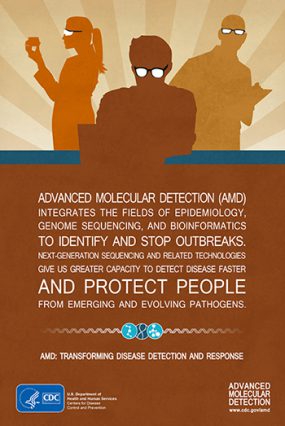
Meet Flu Fighter: John Barnes
Dr. John Barnes is a microbiologist and team lead for CDC’s Influenza Genomic teams. Flu viruses are constantly changing and evolving. Dr. Barnes and his team are essentially looking for changes (“mutations” or “substitutions”) within the genes of flu viruses.
| Learn More |
Flu Fighters
Flu Fighter: John Barnes
Meet flu fighter Dr. John Barnes, microbiologist and team lead for CDC’s Influenza Genomics team. In a world where influenza (flu) viruses are constantly changing and evolving, this team examines (sequences) the genomes of thousands of influenza viruses a year, looking for any early warning signs that, among other things, might spell trouble for how well the seasonal flu vaccine will work at protecting us against those viruses. Essentially, the team is looking for changes (“mutations” or “substitutions”) within the genes of influenza viruses. Gene sequencing also can provide insight into how an influenza virus becomes resistant to the antiviral drugs used to treat flu illness.
Three years ago, Dr. Barnes and his team took on the monumental task of creating a pipeline capable of sequencing whole flu genomes from all of the influenza specimens submitted as part of routine surveillance – equal to roughly 6,000 specimens a year! This mission is at the core of CDC’s advances in applying next-generation technologies together with partner laboratories to better track and monitor the ever-changing influenza virus. The advanced molecular detection flu project is currently operated through CDC and three other public health laboratories. Each laboratory uses next-generation technology to rapidly sequence influenza viruses they receive, mapping all of the genes of each influenza virus in what amounts to roughly 13,500 bits of information per virus. During this phase, each genome is mapped many times over, which helps to ensure the accuracy of the final genome map. To give you an idea of just how much data they’re producing during this process, for a single virus, if each bit of information were a typed word on a single-spaced 500-word page, one influenza virus would be 27 pages long — and that 27-page document would be created from scratch hundreds of times!

To manage all of the data being produced, CDC and partner laboratories use cloud-based computing; this computing structure allows researchers to quickly assemble, make sense of, and share the data. What we get from this effort is a continuously updated snapshot of circulating influenza viruses and an in-depth look at their potential impact on the public’s health.
Name: John Barnes
Title: Research microbiologist and team lead for the Influenza Genomics team
Location: Atlanta, GA
- What role do you play in fighting flu?
 I am the team lead for CDC’s Influenza Genomics team, which manages one of the largest influenza gene sequencing labs in the world. We call ourselves the tech geeks behind CDC’s flu laboratory and surveillance work. Our lab analyzes flu viruses from around the country and world and conducts next generation sequencing to assess the genetics and genomic makeup of different influenza viruses. We share our expertise with other public health labs across the United States via cloud-based computing technology which allows CDC experts to assist other experts in assembling and analyzing genomics data being generated by other laboratories. CDC regularly makes gene sequences available for other researchers to study by posting the information in publicly accessible databases including GenBank, National Center for Biotechnology Information, and the Global Initiative on Sharing All Influenza Data (GISAID). The goal is to create a large volume of complex data that then is analyzed to give us a complete picture of the viruses circulating and their impact on the country’s health.
I am the team lead for CDC’s Influenza Genomics team, which manages one of the largest influenza gene sequencing labs in the world. We call ourselves the tech geeks behind CDC’s flu laboratory and surveillance work. Our lab analyzes flu viruses from around the country and world and conducts next generation sequencing to assess the genetics and genomic makeup of different influenza viruses. We share our expertise with other public health labs across the United States via cloud-based computing technology which allows CDC experts to assist other experts in assembling and analyzing genomics data being generated by other laboratories. CDC regularly makes gene sequences available for other researchers to study by posting the information in publicly accessible databases including GenBank, National Center for Biotechnology Information, and the Global Initiative on Sharing All Influenza Data (GISAID). The goal is to create a large volume of complex data that then is analyzed to give us a complete picture of the viruses circulating and their impact on the country’s health.
- What is the most rewarding part of your work?The most rewarding part is working on a topic as interesting and impactful as flu. I come from a research background, and what I have found in my work at CDC is our research has a direct impact on the larger picture of public health. We collect data and generate reports that inform important decisions about flu prevention and preparedness. We collect data that tell us the types of viruses circulating and how they have evolved or changed from what we have seen in the past. As part of this work, we also have the opportunity to collaborate and implement new technologies, which expand the amount and depth of information available about flu viruses. Seeing the real-life impact your work makes is exciting and very rewarding.
- What is the most difficult part of your work?Flu is both a fascinating and frustrating virus to study. Influenza viruses have a unique ability to move through genetic space very quickly. Every week, there is a new “curveball” that could literally leave us looking at changes in the viruses that we have never seen before. To understand and fully grasp the genetic and genomic changes in influenza viruses and their impact on public health, we need a large amount of really detailed data. That is where our lab comes in with advanced molecular technology, to give us a deeper, and at the same time broader, look into these viruses.
- How serious is flu? What should people know about the risk of flu?Flu is very serious. Historically speaking, seasonal flu is one of the deadliest diseases in the world. Additionally, we understand that with the evolution of flu viruses, we are always monitoring and keeping a close eye on a few viruses that have the potential to evolve and spread at pandemic levels.
- What would you say to those who are hesitant to get the flu shot?Flu shots have been around for a long time and have an excellent safety record. Some people note that flu most severely affects the very young and very old. Every person who gets a flu vaccine reduces their chance of spreading the virus. This could have significant impact on protecting those who are at the highest risk. Getting yourself vaccinated against flu can protect not only yourself, but those around you who may suffer the most if they become ill. As the world has gotten smaller through travel, flu has to be understood through a global perspective.






















.png)











No hay comentarios:
Publicar un comentario